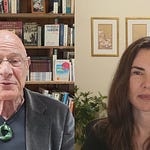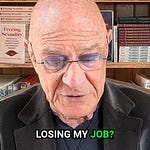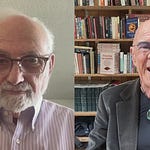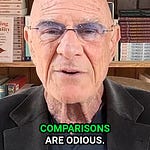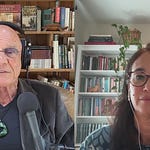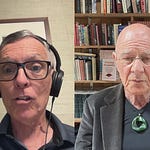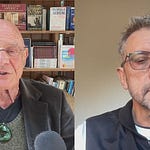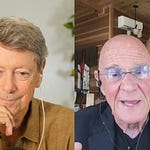Dear friends,
For over six decades, I've observed a troubling pattern among healers, medical professionals, and caregivers: we often neglect our own well-being while tending to others. This cycle of self-sacrifice ultimately diminishes what we can offer those we serve.
That's why my conversation with Satya—a Portuguese healer who transitioned from professional surfing to founding a transformative school for practitioners—resonated so deeply. Her journey from childhood trauma to creating a sanctuary of healing mirrors my own path in establishing Wilbur Hot Springs as a place of natural restoration.
What struck me most was our shared understanding that true healing occurs not just through techniques or theories, but through communion with nature and the cultivation of inner silence.
In an age when healers face unprecedented demands and burnout, Satya's practical wisdom about slowing down, processing personal trauma, and building community offers a vital counterbalance to our culture's addiction to productivity.
Golden light,
Dr. Richard L. Miller
Links & Resources
Work with Me
After six decades as a practicing psychotherapist, I'm offering limited opportunities to work directly with me. I bring extensive experience addressing anxiety, depression, trauma, relationship challenges, addiction, and psychedelic integration.
One-to-one sessions - Individual therapy tailored to your specific needs and goals. To request an appointment, email DrRichardLMiller@gmail.com with subject line "Contact Request." Include what you hope to accomplish and your phone number.
Group Therapy - Join the waitlist for a small, curated group committed to personal growth. Experience community support while learning from others and developing tools for lasting transformation.
Mind Body Health Seminars - My comprehensive 10-week program combines experiential practice with foundational teaching on mind control techniques. This structured approach provides a complete toolkit for mastering your mind. Waitlist coming soon.
Why the Best Healers Never Stop Healing Themselves
A conversation with trauma specialist Satya Rocha reveals the uncomfortable truth about sustainable healing work
The moment I heard Satya Rocha describe her Portuguese village, I knew we were kindred spirits. Here was someone who had made the same radical choice I'd made over 50 years ago—leaving conventional success behind to create healing in nature.
But our conversation revealed something more profound than shared values. It exposed the dangerous myth that healers eventually "arrive"—that there's some point where the work on ourselves is finished.
The Sacred Wound That Never Fully Heals
"This wound that I call the sacred wound," Satya explained, describing her ongoing journey with childhood sexual trauma. "The more I go, the more I have compassion for... I couldn't do better. I couldn't because I just arrived now to this layer that maybe I'm ready."
At 86, with over 60 years of practice, I can attest to this truth. The remnants of my own childhood sexual abuse still surface. Not daily, not dramatically, but they're there—little threads of feeling like I've done something wrong.
This isn't failure. It's humanity.
The most effective healers aren't those who've conquered their demons. They're those who've learned to dance with them, to hold space for their own ongoing healing while serving others.
The Dangerous Myth of the "Fixed" Healer
Too many healers—therapists, doctors, coaches—operate from the dangerous belief that they need to have it all figured out before they can help others. This creates two problems:
First, it's a lie. There is no "fixed." There is no point where growth stops, where triggers disappear, where we've unpacked every layer of conditioning and trauma.
Second, it makes us less effective. The healer who pretends to be beyond struggle cannot truly meet others in theirs. They become teachers from pedestals rather than guides walking alongside.
Why Nature Heals What Therapy Cannot Touch
Both Satya and I discovered something conventional psychology often misses: nature heals at levels that talking cannot reach.
"Being in nature, surfing every day in this liquid environment that we all born from the belly of our mother," Satya reflected. "This was one of the biggest healings that I had in my life."
For me, it was creating Wilbur Hot Springs—a healing sanctuary surrounded by thousands of acres of protected wilderness, powered entirely by solar energy, with no cell service or industrial electricity.
Nature doesn't just provide a pretty backdrop for healing. It recalibrates our nervous systems, reconnects us to rhythms deeper than our conditioned patterns, and reminds us we're part of something larger than our stories.
The Inner Silence That Changes Everything
Perhaps the most practical insight from our conversation was Satya's emphasis on developing "inner silence"—not as emptiness, but as spaciousness.
"The more we develop this inner silence mind that can be sharp... and not be distracted, but focusing, that allowed us to sustain a lot more in a lot of different situations."
This isn't about meditation retreats or special techniques. It's about learning to be present with whatever arises—in ourselves and others—without immediately needing to fix, change, or escape it.
The Body Keeps the Score (And the Solution)
"The pain stays memorized," Satya explained about her recent breakthrough work with psychedelic-assisted therapy. "No therapy, no good food... they help but was not really releasing."
She had to go through the pain in her body, not around it. This aligns with everything we know about trauma: it's stored somatically, and it must be released somatically.
The mind can understand. The heart can forgive. But the body must release.
Practical Self-Care for Sustainable Healing Work
Our conversation wasn't just philosophical. Satya shared concrete practices that sustain her:
Daily exercise (she still surfs when possible)
Proper nutrition adapted to her body's needs
Regular inner process work—even after decades of healing
Boundaries around work—saying no to preserve yes for what matters
Community—living in relationship, not isolation
But the foundation of all these practices is honesty about her ongoing need for healing.
The Quantum Field of Healing
"We as healers... our vibration will interfere in the quantum field of the person that comes for us to ask for support," Satya observed.
This isn't mystical bypassing. It's acknowledging that our unhealed wounds create blind spots, projections, and limitations in how we can serve others.
The client who triggers our unprocessed anger. The story that reminds us of our ungrieved loss. The success that threatens our unhealed inadequacy.
Every unhealed aspect of ourselves becomes a limitation in our service to others.
Don't Abandon Yourself
Satya's closing message hit like a bell: "Don't abandon yourself. Take responsibility for your life and take care of who you truly are, because life is giving us, has a gift, we sometimes just waste it with so many mind games. Don't abandon yourself. You really matter."
For healers, this isn't selfish—it's essential. Your ongoing healing isn't separate from your service. It IS your service.
The healer who has the courage to keep facing their own darkness can hold space for others to face theirs.
The healer who practices radical self-care gives others permission to do the same.
The healer who admits they're still healing breaks the dangerous myth of the guru who has transcended humanity.
The Path Forward
After six decades of this work, I've learned that sustainable healing—for ourselves and others—requires:
Humility about what we don't know and haven't healed
Nature as medicine, not just backdrop
Community that supports authentic growth
Practices that address body, mind, and spirit
Honesty about our ongoing need for healing
The best healers aren't those who've arrived. They're those still willing to do the work.
To hear the full interview with Satya, visit mindbodyhealthpolitics.org, where you can access this and hundreds of other interviews from our archives—completely free and open-source.
Now Available: Psychedelic Medicine at the End of Life
You can now order my latest book, Psychedelic Medicine at the End of Life: Dying Without Fear. This work represents a culmination of my decades-long journey as a clinical psychologist, exploring how psychedelics can transform our approach to death and dying.
The book examines how substances like LSD, MDMA, and psilocybin can be powerful tools in confronting our fears of mortality, ultimately leading to richer, more fulfilling lives. I'm honored to include insights from renowned experts in the field, as well as my own experiences.
Here's what some esteemed colleagues are saying:
James Fadiman, Ph.D., calls it "a deeply uplifting, clear, and compassionate guide to dying and how psychedelics, used correctly, diminish our fears about approaching the door that opens at the end of our life."
Charles S. Grob, M.D., describes it as "a masterful overview of an area of vital importance to our modern world... a valuable resource and contribution to the growing field of psychedelic medicine."
Julie Holland, M.D., notes that "Psychedelics may offer a mini-death rehearsal, offering a glimpse of spiritual oneness, enabling us to be less afraid at the end of our lives."
I hope this book will inspire meaningful conversations and new perspectives on how we approach the end of life.
My Books:
Psychedelic Medicine at the End of Life: Dying Without Fear (release date: November 5)
Freeing Sexuality: Psychologists, Consent Teachers, Polyamory Experts, and Sex Workers Speak Out
Psychedelic Wisdom: The Astonishing Rewards of Mind-Altering Substances
Psychedelic Medicine: The Healing Powers of LSD, MDMA, Psilocybin, and Ayahuasca
Integral Psychedelic Therapy (co-edited with Jason A. Butler & Genesee Herzberg)




